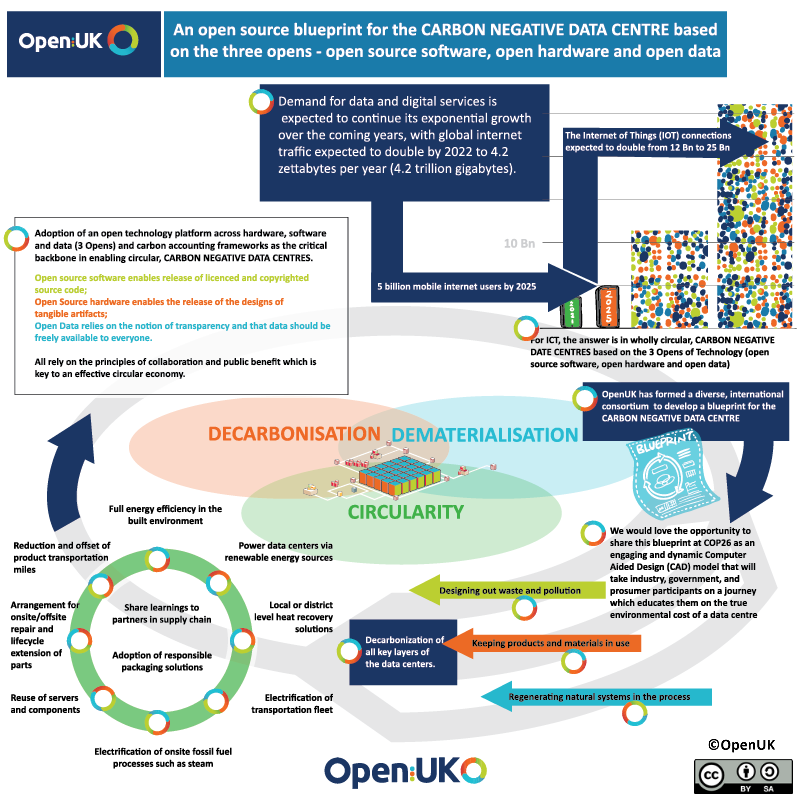
Huge thanks to Ali Fenn and Fahmida Bangert at ITRenew, John Laban at the Open Compute Project and Michael Oghia at SDI Alliance for their substantial contributions to this post.
So many aspects of our life – personal, professional, medical, educational, entertainment – are fueled by technology. While technological innovation should be leveraged to help solve the world’s most pressing social and environmental challenges, the Information and Communication Technology (ICT) industry is going in the wrong direction on carbon and climate mitigation.
The Shift Project estimates that on its current path, the global ICT industry could be on track to grow from ~4% of global GHG today to nearly 8% by 2025. The gradual shift to renewable energy, while important, is a small part of the solution. There are greater than 50m tonnes of e-waste produced annually – this number is growing and we are running out of the Earth’s minerals required for electronic components.
Data centers are the backbone of the ICT industry, and their scale is important and immense (source):
- Demand for data and digital services is expected to continue its exponential growth over the coming years, with global internet traffic expected to double by 2022 to 4.2 zettabytes per year (4.2 trillion gigabytes).
- The number of mobile internet users is projected to increase from 3.8 billion in 2019 to 5 billion by 2025, while the number of Internet of Things (IoT) connections is expected to double from 12 billion to 25 billion.
Bold and responsible action is urgently needed and the opportunity to do so clearly emerges: Operational phase energy (Scope 1 and 2) efficiency is essential, but only a small piece of the equation. Scope 3 emissions in the supply chain require intense focus and mitigation in this era of sustainable development via circular data center infrastructure and corresponding solutions.
For the ICT industry, the answer is in wholly circular, carbon negative data centres based on the 3 Opens of technology (open source software, open hardware and open data). This needs to be inclusive of supply chain scope 3 emissions. It also needs to be fully transparent, particularly as we’re seeing many of the organisations that are announcing plans for their own net-zero data centres, are often doing so in silos and in a closed manner – so processes, insights, and economies of scale are seldomly shared and implemented with all industry constituents in the interest of the collective solution.
OpenUK has formed an international consortium to develop an open source blueprint for the carbon negative data centre. At the time of writing, the consortium includes ITRenew (US), the Open Compute Project (US), the Octopus Energy Centre for Net Zero (UK), the Scotland 5G Centre (UK), the Sustainable Digital Infrastructure Alliance (DE) and ORCA Computing (UK).
The blueprint will enable a circular economy, based on the principles of designing out waste and pollution, keeping products and materials in use, and regenerating natural systems in the process.
This Carbon Negative Data Centre Blueprint will outline 3 key pillars:
- Decarbonisation of all key layers of the data centres: Specifically, the requirements and opportunities corresponding to the physical (built) infrastructure, IT hardware, and broader municipal energy usage and recapture, providing actionable guidance for implementation of solutions, in part and in whole. Some of these opportunities are available today but are under-utilised in the context of data centres.
- For scope 1 and 2 direct emissions, data centres need to deploy:
- Full energy efficiency in the built environment
- Power data centres via renewable energy sources
- Local or district level heat recovery solutions
- Electrification of transportation fleet
- Electrification of onsite fossil fuel processes such as steam
- For scope 3 indirect supply chain emissions that require a circular solution, key strategies include:
- Reuse of servers and components to the fullest extent
- Arrangement for onsite and offsite repair and lifecycle extension of server and network parts
- Reduction and offset of product transportation miles
- Adoption of responsible packaging solutions that include all packaging materials coming from recycled content and for them to be further reusable, recyclable, or compostable, eliminate single use plastic in IT asset packaging , and dramatically reduce packaging weight.
- Share learnings linked to reuse, disassembly, reassembly, and recycling to all partners in the supply chain
- Adoption of an open technology platform across hardware, software and data (3 Opens) and carbon accounting frameworks as the critical backbone in enabling circular, carbon negative data centres. Open source software enables release of licensed and copyrighted source code; Open Source Hardware enables the release of the designs of tangible artefacts; and Open Data relies on the notion of transparency and that data should be freely available to everyone. All rely on the principles of collaboration and public benefit which is key to an effective circular economy.
- Commitment to increased transparency, inclusive economy, and equitable access: Transparency is also a key component needed to build trust within communities and transform digital infrastructure into a holistic solution that contributes to sustainable cities (SDG 11) – for example from heat waste recycling into homes, which can replace the reliance on natural gas, to decreasing the cost of access, particularly for marginalised communities, due to local proximity to data centres.
The blueprint will be creative commons licensed and demonstrate how a combination of these solutions will meet the zero-waste industry goals for circularity with over 90% dematerialisation. It will also showcase how solutions can contribute to the global goal of 80% decarbonisation.
We have shared the vision for this blueprint with the COP26 organising committee, where we hope to take industry, government, and prosumer participants on a journey which educates them on the true environmental cost of a data centre, and then providing them with a path and call to action to urgently invest in, regulate and adopt this open technology, vendor independent solution in order to reach net-zero by 2030.





